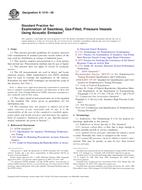Potrebujeme váš súhlas na využitie jednotlivých dát, aby sa vám okrem iného mohli ukazovať informácie týkajúce sa vašich záujmov. Súhlas udelíte kliknutím na tlačidlo „OK“.
ASTM E1419-09
Standard Practice for Examination of Seamless, Gas-Filled, Pressure Vessels Using Acoustic Emission
Automaticky preložený názov:
Štandardná prax pre vyšetrenie bezšvových, plnené plynom, tlakové nádoby s využitím akustickej emisie
NORMA vydaná dňa 1.2.2009
Informácie o norme:
Označenie normy: ASTM E1419-09
Poznámka: NEPLATNÁ
Dátum vydania normy: 1.2.2009
Kód tovaru: NS-41705
Počet strán: 7
Približná hmotnosť: 21 g (0.05 libier)
Krajina: Americká technická norma
Kategória: Technické normy ASTM
Anotácia textu normy ASTM E1419-09 :
Keywords:
acoustic emission, flaws in steel vessels, gas pressure vessels, seamless gas cylinders, seamless steel cylinders, seamless vessels, Acoustic emission (AE) testing--metals/metallic materials, Flaw detection, Gas cylinders, Gas pressure systems/applications, Industrial metals/alloys, Pressure testing--gaseous environments, Pressure vessels, Seamless pressure vessels tubes, Steel pipe, ICS Number Code 23.020.30 (Pressure vessels, gas cylinders)
Doplňujúce informácie
| Significance and Use | ||||||||||||||||
|
Because of safety considerations, regulatory agencies (for example, U.S. Department of Transportation) require periodic examinations of vessels used in transportation of industrial gases (see Section 49, Code of Federal Regulations). The AE examination has become accepted as an alternative to the common hydrostatic proof test. In the common hydrostatic test, volumetric expansion of vessels is measured. An AE examination should not be used for a period of one year after a common hydrostatic test. See Note 2. Note 2—The Kaiser effect relates to decreased emission that is expected during a second pressurization. Common hydrostatic tests use a relatively high pressure (167 % of normal service pressure). (See Section 49, Code of Federal Regulations.) If an AE examination is performed too soon after such a pressurization, the AE results will be insensitive to a lower examination pressure (that is, the lower pressure that is associated with an AE examination). Pressurization: General practice in the gas industry is to use low pressurization rates. This practice promotes safety and reduces equipment investment. The AE examinations should be performed with pressurization rates that allow vessel deformation to be in equilibrium with the applied load. Typical current practice is to use rates that approximate 500 psi/h (3.45 MPa/h). Gas compressors heat the pressurizing medium. After pressurization, vessel pressure may decay as gas temperature equilibrates with ambient conditions. Emission from flaws is caused by flaw growth and secondary sources (for example, crack surface contact and contained mill scale). Secondary sources can produce emission throughout vessel pressurization. When pressure within a vessel is low, and gas is the pressurizing medium, flow velocities are relatively high. Flowing gas (turbulence) and impact by entrained particles can produce measurable emission. Considering this, acquisition of AE data may commence at some pressure greater than starting pressure (for example, 1/3 of maximum examination pressure). Maximum Test Pressure—Serious flaws usually produce more acoustic emission (that is, more events, events with higher peak amplitude) from secondary sources than from flaw growth. When vessels are pressurized, flaws produce emission at pressures less than normal fill pressure. A maximum examination pressure that is 10 % greater than normal fill pressure allows measurement of emission from secondary sources in flaws and from flaw growth. Pressurization Schedule—Pressurization should proceed at rates that do not produce noise from the pressurizing medium and that allow vessel deformation to be in equilibrium with applied load. Pressure holds are not necessary; however, they may be useful for reasons other than measurement of AE. Excess background noise may distort AE data or render them useless. Users must be aware of the following common sources of background noise: high gas-fill rate (measurable flow noise); mechanical contact with the vessel by objects; electromagnetic interference (EMI) and radio frequency interference (RFI) from nearby broadcasting facilities and from other sources; leaks at pipe or hose connections; and airborne sand particles, insects, or rain drops. This practice should not be used if background noise cannot be eliminated or controlled. |
||||||||||||||||
| 1. Scope | ||||||||||||||||
|
1.1 This practice provides guidelines for acoustic emission (AE) examinations of seamless pressure vessels (tubes) of the type used for distribution or storage of industrial gases. 1.2 This practice requires pressurization to a level greater than normal use. Pressurization medium may be gas or liquid. 1.3 This practice does not apply to vessels in cryogenic service. 1.4 The AE measurements are used to detect and locate emission sources. Other nondestructive test (NDT) methods must be used to evaluate the significance of AE sources. Procedures for other NDT techniques are beyond the scope of this practice. See Note 1. Note 1—Shear wave, angle beam ultrasonic examination is commonly used to establish circumferential position and dimensions of flaws that produce AE. Time of Flight Diffraction (TOFD), ultrasonic examination is also commonly used for flaw sizing. 1.5 The values stated in inch-pound units are to be regarded as the standard. The values given in parentheses are for information only. 1.6 This standard does not purport to address all of the safety concerns, if any, associated with its use. It is the responsibility of the user of this standard to establish appropriate safety and health practices and determine the applicability of regulatory limitations prior to use. Specific precautionary statements are given in Section 7. |
||||||||||||||||
| 2. Referenced Documents | ||||||||||||||||
|
Odporúčame:
Aktualizácia technických noriem
Chcete mať istotu, že používate len platné technické normy?
Ponúkame Vám riešenie, ktoré Vám zaistí mesačný prehľad o aktuálnosti noriem, ktoré používate.
Chcete vedieť viac informácií ? Pozrite sa na túto stránku.




 Cookies
Cookies
